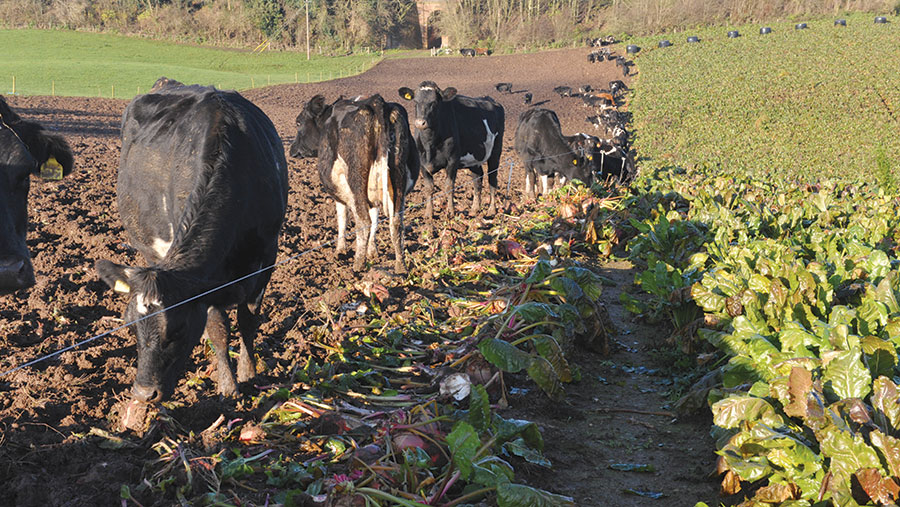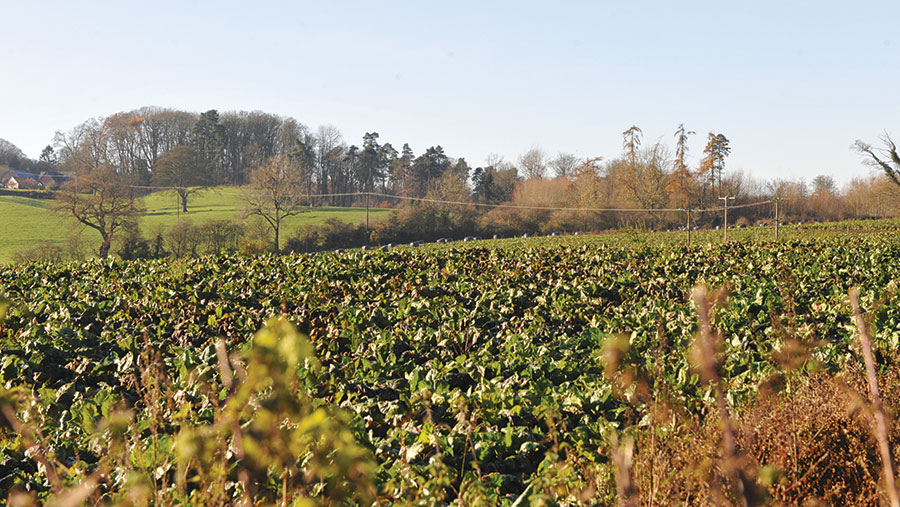Fodder beet proves cost-effective for spring-calving herd

Nick and Liz Haines have been firm believers in growing fodder beet to feed dry cows over the winter.
The couple, who have recently come to the end of their contract farming agreement at Hardwick Farm, near Ellesmere, Shropshire, have grown fodder beet for six years.
They hope to continue to grow it when they move to their new farming enterprise later this spring.
We caught up with them before they left Hardwick Farm to find out more.
Hardwick Farm facts
- 170ha farmed
- 320 spring-calving New Zealand Friesians
- Block calved from 7 February
- Annual average milk yield of 5,800 litres and 480kg milk solids from 1t DM – 500kg concentrates and 500kg brewers’ grain
See also: The benefits of fodder beet and how to get the best from it
Grazing spring-calving dairy cows on fodder beet has provided dry matter (DM) valued at about £60/t at Hardwick.
The farm’s sandy soil has been a good match for the crop, but its impressive DM yield, at 22t/ha, was the main reason for growing it.
Last season, the Haines family drilled 12.1ha of the crop, which cost about £58/t of DM to grow, including rent, seed, fertiliser and tractor work.
“It’s been an expensive crop to grow, but when you factor in the DM yield, its feed value made it almost as cheap as grazed grass,” Mr Haines says.
“After all the costs were deducted, the DM value worked out at about £60/t,” he says.

Nick and Liz Haines with George and Rory
Field selection
The farm’s low average annual rainfall and mix of sandy, clay and peaty soils made field selection critical.
Certain fields wouldn’t grow fodder beet because of the soil type, Mr Haines explains.
Fields were identified 12 months ahead of planting; these were winter grazed by rising one- and two-year-old (RI and R2) heifers the previous winter.
Planting
This land was sacrificed within a planned reseeding programme.
Farmyard manure and slurry were applied to the fields in the spring, and glyphosate was used to burn off any remaining grass in early April.
The land was then subsoiled, ploughed and power harrowed twice before salt was applied before ploughing

Fodder beet
“Fodder beet likes a lot of potash, so we used the salt as a means of replacing it,” says Mr Haines.
Phosphate and potash (P and K) were applied to the seed-bed before drilling – in 2019 the seed was sown on 20 April.
Nitrogen was applied once at the two-leaf stage, in mid-May; in 2019 this was applied at a higher rate than in previous years.
“We had initially been advised to apply N at only 120kg/ha or we would grow lots of leaf and no beet.
“But we spoke to fodder beet specialist Jim Gibbs, and he recommended higher rates, so we put on 200kg/ha in 2019, and the beets have definitely grown bigger,” says Mr Haines.
To balance this higher application rate, the amount of seed sown was reduced to 98,800 seeds/ha instead of the recommended 123,000/ha.
Preparing for grazing
June/July saw baled silage produced to provide the fibre required under the grazing system.
The bales were either laid out in tramlines in the crop after the last application of fungicide in July or August, or along a 3m strip along the field perimeter.
The Haines family budgeted for 8-10kg DM a day a head of fodder beet, plus 2-4kg DM a head of silage, although additional crop was factored in for animals that consumed beet at 14kg a day.
Cows were turned onto the crop at drying-off. Low yielders and thinner cows were dried off early – from 1 November.
At drying-off, a mineral bolus was given to reduce health issues associated with grazing forage crops.
“We had an outbreak of salmonella in our first year of grazing fodder beet and were concerned about the risk from birds contaminating the crop, so after this we vaccinated as a precaution,’’ says Mr Haines.
It is important to transition cows onto the crop slowly, so the first feed was just 2kg DM.
“After we dried off, if the cow hadn’t already grazed fodder beet, she would be housed on a straw diet for a week, with some grazing allowed to prevent gorging,” he says.

High-yielders were often milked up until the beginning of January, so milkers also grazed the fodder beet if weather conditions were favourable.
But when it was too muddy, milkers wouldn’t be grazed, to avoid mud contaminating teats.
To limit contamination, Mr Haines established several temporary gateway points along fence lines.
“We grazed the milkers parallel to a track running down the field edge, so we were not afraid to keep cutting the fence to allow them to come off in different places.”
The feed fence was moved daily, or twice a day during bad weather. And if a field became too wet, cows were moved.
February-calving cows transitioned from the fodder beet in mid-January to a diet of hay, allowing a three-week gap before calving.
“We used tail tapes, so we knew which cows would calve in February, March and April. But we occasionally had the odd cow calve out on the beet. We aimed to avoid this, though,’’ says Mr Haines.
Any fodder beet remaining after calving would be grazed by the milking cows during the spring to finish it off.
Why not kale?
There are many reasons why fodder beet was chosen instead of kale at Hardwick Farm, in addition its yield capability and higher energy value.
“It is easier for the cows to graze beet than kale, because the plant isn’t too tall. It also means it doesn’t short out the electric fences,” says Mr Haines.
But it can take its toll on the soil, he concedes. “We might have caused a bit of short-term compaction and we noticed there was less worm activity.’’
After growing a crop of fodder beet, a field was reseeded with a medium- to long-term grass ley.
Fields were sown in April, and were ready to graze in June, They frequently produced the highest grass yields. “In the very dry summer of 2018, we were grazing the fields where we had grown fodder beet every 14 days,’’ says Mr Haines.
Pros and cons of feeding fodder beet
- Palatability of grass that follows the crop can be an issue. The Haines family noticed higher levels of rejection, possibly due to high levels of P and K.
- Reduced worm activity in those fields, so it took longer to break down cow pats.
- In-calf heifers weren’t grazed on fodder beet, because they put on too much condition and produced big calves. Instead, they went onto deferred grazing and haylage.
- Fields that had grown fodder beet the previous year produced high grass yields.
Nick Haines’ tips for growing and grazing fodder beet
- Use a double feed fence as a safety precaution, as the cows can break through the wire.
- When cows are grazing the crop full time, ensure they have an adequate dry lying area.
- Have spare geared reels and fencing stakes to allow flexibility for setting up in another part of the field if needed.
- Always collect discarded bale wrappers.
